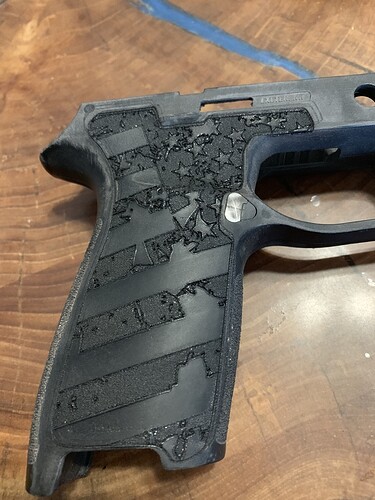The MSDS I found for nylon 6 stated hydrogen cyanide as a byproduct of combustion. I just Googled nylon 6 MSDS.
Depending on which MSDS you read, they either don’t mention Hydrogen Cyanide or say something about trace amounts of Hydrogen Cyanide may be released by some formulations of nylon 6. The most complete one I read included the phrase “The specific materials generated will vary depending on the additives and colorants used, specific temperature, time of exposure and other immediate environmental factors.”
Obviously Hydrogen Cyanide is dangerous, and quickly lethal in large amounts, but your body can actually metabolize small amounts pretty readily. Smoking a cigarette probably releases more HCN, and that’s inhaled directly into your lungs, not vented away. That’s not to say there isn’t a risk, but I’ve not seen anything that says laser cutting Nylon shouldn’t be done, and many articles explaining why Nylon 6 is well suited to laser cutting. If you are engraving a lot of it then it would definitely be prudent to improve ventilation or take other precautions.
Hydrogen Cyanide is frequently discussed when talking about laser cutting ABS, but most people seem to be more concerned about the smoke and mess ABS creates.
That said, I don’t even know if a Sig 320 frame is even Nylon 6, and if so, it they added anything else to it. I know one version of their frame has tungsten somehow infused into the polymer. I think you would have to call SIG and ask them if it’s safe. They don’t appear to publish exactly what their frames are made of.
Here’s an interesting article on nylon 6:
Http://www.creativemechanisms.com/blog/3d-printing-injection-molding-cnc-nylon-plastic-pa
Seems like the processed Nylon 6 would be stable with all the MSDS I searched through. I as well found it mentioned in the sheets just like @DFTC some say nothing, only slightly, or raw/ mass amounts.
To me it’s a very “beware of dog” warning. Definitely don’t inhale constantly, have adequate ventilation, and pay attention. I will still air on the side of caution, but I have done one glock grip before.
I personally feel if it wasn’t a safe material it wouldn’t be readily used for 3D printing. Difference I know, but the heat is still causing a minor reaction.
Melting and combustion are two different things, of course, but nylon tends to be less outgassy than most other printing materials.
I’m new (don’t even have the Glowforge yet) how did you get the pattern to fit so perfect? Can you adjust it in the program? Or does it just recognize where the material is?
No, it will not. You have to move your design to the material, not recommended, or use a jig.
Kind of, but not really.
Up above, in the fifth post, he says he did this:
I’ve had my glowforge for just over two years and I’m not exactly sure how to export a lid camera picture. Personally, I’d try and find a drawing of it on the greater Internet and start from there in my vector editor of choice Inkscape. But clearly, his method works.
If you don’t know, Affinity Designer (he refers to it as Affinity) is one of the vector editors. It is meant for Mac/iOs and is pretty cheap. Inkscape is free, and I read they just released a version that is easy to install and run on a Mac. Inkscape runs just fine on Windows. Adobe Illustrator and CorelDraw are the other two commonly used programs. You’ll want to read up on how to use one of these programs in the Tips and Tricks section. Then read up on jigging. You’ll need to learn how to jig with a glowforge (pretty easy, but some gotchas) if you want to engrave on found objects.
Two new designs. Sig 320 full size frame prepped then engraved and Sig 365 with no prep work.
![image|375x500]This is awesome what settings are you using
there is no “export lid-cam photo” function, but you can always take a screenshot of what is displayed in the GFUI by using the built-in software in your os.
that looks amazing

